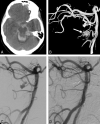Distal aneurysms of cerebellar arteries: incidence, clinical presentation, and outcome of endovascular parent vessel occlusion
- PMID: 17846215
- PMCID: PMC8134400
- DOI: 10.3174/ajnr.A0607
Distal aneurysms of cerebellar arteries: incidence, clinical presentation, and outcome of endovascular parent vessel occlusion
Abstract
Background and purpose: The aim of this retrospective study was to report the incidence, clinical presentation, and midterm clinical and imaging results of endovascular parent vessel occlusion of 11 patients with 13 distal cerebellar artery aneurysms.
Materials and methods: Between January 1995 and December 2006, 2201 aneurysms were treated in our institution. Thirteen aneurysms in 11 patients were located on distal cerebellar arteries (incidence, 0.6%), 8 of them arising from vessels feeding small arteriovenous malformations. There were 6 men and 5 women, ranging from 44 to 70 years of age. One patient with a superior cerebellar artery aneurysm presented with isolated trochlear nerve palsy. Ten patients presented with subarachnoid and intraventricular hemorrhage, and most patients were in poor clinical condition on admission. Aneurysm location was the superior cerebellar artery in 3, the anterior inferior cerebellar artery in 5, and the posterior inferior cerebellar artery in 5. Two patients had 2 aneurysms each.
Results: Eleven aneurysms were treated by simultaneous coil occlusion of the aneurysm and parent artery or occlusion of the parent artery just proximal to the aneurysm. Clinical follow-up was at a mean of 16.5 months (range, 2-40 months). Infarction in the territory of the occluded vessel was apparent on follow-up imaging in 5 of 11 patients, all without functional impairment.
Conclusion: Distal cerebellar artery aneurysms are rare. Most patients present with poor-grade hemorrhage. Endovascular parent vessel occlusion is effective in excluding the aneurysm from the circulation. In most patients, adequate collateral circulation prevents infarction in the territory of the occluded vessel. In this series, when infarction did occur, the clinical consequences were limited.
Figures




Similar articles
-
Endovascular treatment of peripheral cerebellar artery aneurysms.AJNR Am J Neuroradiol. 2003 Jun-Jul;24(6):1208-13. AJNR Am J Neuroradiol. 2003. PMID: 12812956 Free PMC article.
-
Endovascular coil embolization of ruptured and unruptured posterior circulation aneurysms: review of a 10-year experience.Neurosurgery. 2007 Apr;60(4):626-36; discussion 636-7. doi: 10.1227/01.NEU.0000255433.47044.8F. Neurosurgery. 2007. PMID: 17415199
-
Ruptured Distal Posterior Inferior Cerebellar Artery (PICA) Aneurysms Associated with Cerebellar Arterial Venous Malformations (AVMs): A Case Series and Review of the Literature Demonstrating the Need for Angiographic Evaluation and Feasibility of Endovascular Treatment.World Neurosurg. 2017 Jan;97:751.e7-751.e13. doi: 10.1016/j.wneu.2016.10.081. Epub 2016 Oct 25. World Neurosurg. 2017. PMID: 27793767 Review.
-
Coil Embolization Results of the Ruptured Proximal Posteriori Inferior Cerebellar Artery Aneurysm: A Single-Center 10 Years' Experience.World Neurosurg. 2018 Sep;117:e645-e652. doi: 10.1016/j.wneu.2018.06.105. Epub 2018 Jun 23. World Neurosurg. 2018. PMID: 29945000
-
Endovascular parent vessel sacrifice in ruptured dissecting vertebral and posterior inferior cerebellar artery aneurysms: clinical outcomes and review of the literature.J Neurointerv Surg. 2016 Aug;8(8):796-801. doi: 10.1136/neurintsurg-2015-011732. Epub 2015 Aug 3. J Neurointerv Surg. 2016. PMID: 27417905 Review.
Cited by
-
Management of anterior inferior cerebellar artery aneurysms: endovascular treatment and clinical outcome.AJNR Am J Neuroradiol. 2011 Jan;32(1):159-64. doi: 10.3174/ajnr.A2360. Epub 2010 Nov 4. AJNR Am J Neuroradiol. 2011. PMID: 21051509 Free PMC article.
-
Endovascular treatment of a small aneurysm of the superior cerebellar artery with a flow-diverter device. A case report.Neuroradiol J. 2013 Jun;26(3):327-31. doi: 10.1177/197140091302600313. Epub 2013 Jul 16. Neuroradiol J. 2013. PMID: 23859291 Free PMC article.
-
Endovascular management of distal anterior inferior cerebellar artery aneurysms: Report of two cases and review of the literature.Surg Neurol Int. 2011;2:95. doi: 10.4103/2152-7806.82577. Epub 2011 Jun 30. Surg Neurol Int. 2011. PMID: 21748047 Free PMC article.
-
Unusual delayed presentation of head trauma complicating outcome of facial nerve decompression surgery.BMJ Case Rep. 2013 Aug 20;2013:bcr2013200188. doi: 10.1136/bcr-2013-200188. BMJ Case Rep. 2013. PMID: 23964046 Free PMC article.
-
Endovascular and microsurgical treatment of superior cerebellar artery aneurysms.J Cerebrovasc Endovasc Neurosurg. 2012 Mar;14(1):29-36. doi: 10.7461/jcen.2012.14.1.29. Epub 2012 Mar 31. J Cerebrovasc Endovasc Neurosurg. 2012. PMID: 23210027 Free PMC article.
References
-
- Locksley HB. Natural history of subarachnoid hemorrhage, intracranial aneurysms and arteriovenous malformations: based on 6368 cases in the cooperative study. J Neurosurg 1966;25:215–39 - PubMed
Publication types
MeSH terms
LinkOut - more resources
Full Text Sources
Medical
